Progreso
- Sites of Interest
Besides enjoying the
sun and white beaches of Progreso, explore
the wonderful Mayan World. Just 2 hours
away the famous worldwide ruins of Chichen
Itza are located. Its largest
structures are the Kukulcan pyramid, where
the sun phenomenon of the equinox can
be observed; The Temple of the Warriors,
the Temple of the Jaguars, the Market,
and the Caracol, also known as the Observatory,
and the cenote, or sacred water hole,
where the ritual sacrifices of young damsels
and children took place.
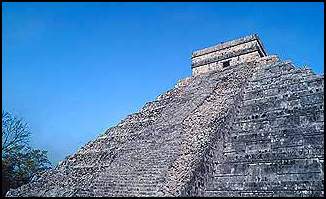 |
Kukulcan Pyramid
- Chichen Itza |
Located one hour away
is Uxmal, the most important
site of the Classic period, to the south
of Merida, where you can enjoy the highest
expression of the Puc architectural style,
which is defined by its lavish geometric
designs, the beautifully proportioned
constructions, as the Cuadrangulo de las
Monjas (Quadrilateral of the Nuns) and
the Governor's Palace, which is decorated
with numerous masks of the rain god, Chac,
with its undulated nose. You can also
appreciate that each one of the pyramids
was built in intervals of 52 years, a
mystic cycle for the Mayas. You can also
find an oval pyramid, known as the Magician's
Pyramid, or the Temple of the Soothsayer.
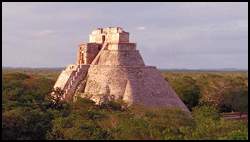 |
Temple of the
Soothsayer, Uxmal |
You can visit the beautiful City of Merida,
capital of the State of Yucatán
that joins its colonial style with the
advantages of a modern city, with its
colonial sites and entertainment centers.
Around the city you can visit the reconstructed
and restored haciendas and convents.
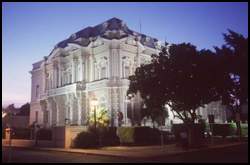 |
Canton Palace
Museum, Merida |
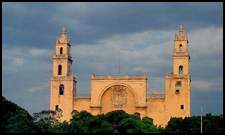 |
Cathedral of
Mérida |
Or enjoy the beautiful natural landscapes
of the Yucatan, such as the Cenotes and
the Flamingos of Celestun that can be
seen from a beautiful wooden tower just
a few kilometers away.
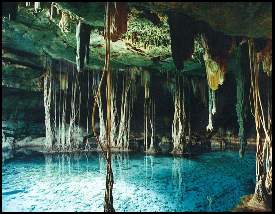 |
Dzitnup Cenote |
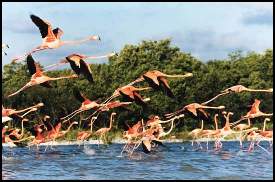 |
Flamingos Refuge,
Celestun |
Located just 20 minutes away are the
Dzibitzaltun ruins which are famous for
their natural spectacle of receiving the
sun during the spring equinox.
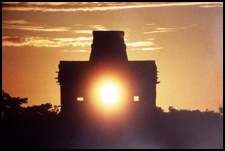 |
Dzibitzaltun |
YUCATAN
The yucatecan architecture
is enriched by important pre-Hispanic buildings
that can be admired at the archaeological
sites, or inside the same cities; its aesthetics
and greatness reflects the splendor of the
Mayan culture.
The regional dress, distinctive
of the cultural heritage of our times, is
worn at the popular festivities and in the
folkloric events, with pride and elegance.
The beautiful embellished attire that are
displayed by the yucatecan Mestizas at the
festivities are called "terno",
derived from the huipil that is the attire
used on daily basis, and features a jerkin,
an huipil and fustian.
The yucatecan gastronomy
includes more than 500 dishes, unique in flavors
and aromas, with a mixture of indigenous culinary
traditions of European and Asian descent,
especially Lebanese that make it one of the
most important in the country. And what can
be better than to accompany your meal with
the music of the troubadours and the world
famous yucatecan beer.
Most of the traditional dishes
have their origins in Spanish-yucatecan recipes,
that when prepared in this land obtains new
flavors and ingredients, until shaping the
wide variety of dishes. One of the most famous
dishes is the "poc chuc", made at
the coast, with fresh, flat meat, cooked on
hot stones, and without oil, and that at a
later date began being commonly prepared with
pork meat.
Natural
protected area.
 Ria
Lagartos Fauna Refuge. Its importance resides
in being one of the few sites that an estimate
population of 30 thousand individual pink
flamingos nest, breed and rest from March
to October. It was decreed a Wild Fauna Refuge
area on June 23rd, 1979, and is 47 thousand
hectares in size. Its geographical location
provides contact features with the endemic
flora and fauna systems of scientific and
cultural interest. In 1986, the UN placed
it on the Wetlands of International Importance
list. The slough is about 69 km long and 1
km wide, with an average depth of 1.1m. On
its eastern side there is a salty lagoon called
Flamencos that was formed when the El Cuyo
Bridge was built. Las Coloradas and El Cuyo
are also part of this reserve.
Ria
Lagartos Fauna Refuge. Its importance resides
in being one of the few sites that an estimate
population of 30 thousand individual pink
flamingos nest, breed and rest from March
to October. It was decreed a Wild Fauna Refuge
area on June 23rd, 1979, and is 47 thousand
hectares in size. Its geographical location
provides contact features with the endemic
flora and fauna systems of scientific and
cultural interest. In 1986, the UN placed
it on the Wetlands of International Importance
list. The slough is about 69 km long and 1
km wide, with an average depth of 1.1m. On
its eastern side there is a salty lagoon called
Flamencos that was formed when the El Cuyo
Bridge was built. Las Coloradas and El Cuyo
are also part of this reserve.
Fauna of the area. This area,
likewise, is also a refuge area to more than
250 species of migratory and resident birds,
as the ruddy quail-dove that gives off one
of the most characteristic morning spring
sounds of the area; the blue-winged teal,
that comes each year for winter time all the
way from Canada between September and October,
has here its most important concentration
in our country, and remains here until January;
the northern pintail, the whistling duck,
and the muscovy duck, the population which
is decreasing in Mexico due to its intense
hunting. Near the village of Las Coloradas,
there are large mangrove areas inhabited by
great egrets and blue herons. At the shore
of the slough can be found colonies of pink
flamingos near their nests, made with mud
of the estuary; nests built during the first
months of the year, when they return from
their annual migration from the other side
of the peninsula, in Celestun.
There are many wild endemic
species, as the spider monkey, the tepezcuintle,
agouti, white-tailed deer, ocofaisan (a type
of pheasant), crocodile and jaguar, among
others. Here, you can find 19 classes of ornithofauna
of the 27 that there are world wide, and approximately
121 bird varieties. There are reptiles, as
the crocodile; coveted mammals due to their
meat, as the tepzcuintle, wild rabbit (agouti),
raccoon and the grison. At the east end you
can watch the ant bear, cacomixle, sabin (type
of weasel) and the tyra. At the Flamingo's
lagoon there are estuarine areas with fishes
as the mullet and bass.
The area is protected by the SEMARNAP, (Mexican
Secretariat of Marine, Natural Resources and
Fishery) with a permanent debar, for avoiding
the capture or hunting of the crocodiles,
deer, flamingo, grison, jaguar and marine
turtles, and for protecting mainly the hawksbill,
irreversibly endangered animal specie. During
summer time, arrive at the refuge beaches
the leatherback, hawksbill and loggerhead
turtles. Visitors are urged not to disturb
the turtles' spawning, because the nesting
season goes from April until mid September,
comprising the complete summer vacation season.
Petenes. At the reserve you can find several
types of vegetation, as the sand dunes, with
species not found in any other area, as the
Chi'it and Kuká palm trees. There is
also aquatic and flooding forest vegetation,
conformed by mangroves, tule groves and petenes
(forested hummocks). These last are ecosystems
shaped as islands, in which at the center
you can find a cenote or water eye, which
nourishes the estuary. It is one of the few
sites in the world where these Petenes exist.
Most of the plant species found at these sites
are enlisted as endangered species, as is
the case of the most beautiful orchids in
the continent.
Beach. Fine sands with shell
fragments, regular slope and soft surf. The
beach is the most visited site, and the people
get there in rented boats.
Boat rental at the pier.
This service is provided daily. With regards
to the natural attractions, the main one,
undoubtless, is the ride through the pink
flamingo's sanctuary. The ride lasts about
3 to 4 hours and includes a visit to the nesting
area of the flamingos, the Chiquilá
Balneary and the beach.
Archaeology
 Chichen
Itza Archaeological Site. Located 2 km away
of the village of Piste. Its name means in
the Maya language "the mouth of the itzaes
well". Its peak time was between the
years 1000 and 1250 A.D. It's a site that
covers a large territory with monumental architecture.
Even though in its peak time it had hundreds
of construction sites, today only about thirty
can still be visited, because the rest are
just knolls of stones, some of them covered
by brush.
Chichen
Itza Archaeological Site. Located 2 km away
of the village of Piste. Its name means in
the Maya language "the mouth of the itzaes
well". Its peak time was between the
years 1000 and 1250 A.D. It's a site that
covers a large territory with monumental architecture.
Even though in its peak time it had hundreds
of construction sites, today only about thirty
can still be visited, because the rest are
just knolls of stones, some of them covered
by brush.
The House of the Deer. The
name was given because on one of its walls
a sketch with the shape of a deer was found.
It's built on top of a platform with a stairway
at its center. Both the facades and crenellations
are not ornamented.
The Nunnery. Is one of the
most impressive of the massive buildings at
Chichen Itza, and the main one of the Maya
Classic period: it has two stories, each build
at a different period, the first with long
halls formed by rooms, and the second with
just one room, and can be reached by the only
stairway depicting phytomorphous and zoomorphous
figures. It's 18 meters high.
The Nunnery Annex. Attached
to the base, there are several rooms which
the distribution plan has as an L shape. The
main facade is decorated with masks of Chac,
the God of the Rain, and a sitting human figure,
with headdresses and surrounded by feathers.
This craving is located on top of the doorway,
as well as a series of glyphs that are dated
apparently from the year 880 A.D. The west
facade has Chac masks and lattice panels.
The Caracol. The name was
given because of the snail-like stairway that
conveys to the top of the building. The building
belongs to a transition stage between the
Classic and Post classic periods, because
it was built around 900 A.C., but is of a
classic Puc Style. This distinctive structure
is based on two superimposed platforms. It's
important to outline that this type of structure
is associated with the God of Wind. Its top
floor allows observations, through portholes,
the spring equinox (March 21st), as well as
the descent of the moon on its way through
the horizon, it is because of this that there
is no doubt that the astronomic observation
was a very important activity among the pre-Hispanic
people.
Civil
Architecture
 House
of Montejo (Merida). Located on 63 Street,
between 60 and 62 Streets. This house belonged
to the Conqueror of Yucatan, Francisco de
Montejo "El Adelantado"; it was
built between 1543 and 1549 by his son Francisco
de Montejo "the Young". It is a
jewel of both historic and artistic value,
for it represents the most remarkable of the
civil architecture in the plateresque style
in Mexico. The only intact remains of this
building are its two-bodied doorway: The lower
side is in plateresque style in the form of
an architrave. The building sits on a soubassement
or a pinth course. The doorway is flanked
by two Corinthian columns and the frame has
chiseled tablets in high relief combined with
renaissance motifs. The key of the door is
formed by a bearded man figure holding on
his back the central part of the ledge. In
the upper part of the façade there
are four portraits (three of them are under
the cornice) and it's possible they are of
Francisco de Montejo "the Young",
his wife and son. On top of the iron balcony
stands out the coat of arms of Montejo "El
Adelantado". The border has a crowned
shield of rampant lions and is topped with
the bust of a man, as the main human ornament
and animal figures. The upper part of the
doorway has Elizabethan gothic characteristics.
However, it must be noted that the building
has a substantial indigenous influence.
House
of Montejo (Merida). Located on 63 Street,
between 60 and 62 Streets. This house belonged
to the Conqueror of Yucatan, Francisco de
Montejo "El Adelantado"; it was
built between 1543 and 1549 by his son Francisco
de Montejo "the Young". It is a
jewel of both historic and artistic value,
for it represents the most remarkable of the
civil architecture in the plateresque style
in Mexico. The only intact remains of this
building are its two-bodied doorway: The lower
side is in plateresque style in the form of
an architrave. The building sits on a soubassement
or a pinth course. The doorway is flanked
by two Corinthian columns and the frame has
chiseled tablets in high relief combined with
renaissance motifs. The key of the door is
formed by a bearded man figure holding on
his back the central part of the ledge. In
the upper part of the façade there
are four portraits (three of them are under
the cornice) and it's possible they are of
Francisco de Montejo "the Young",
his wife and son. On top of the iron balcony
stands out the coat of arms of Montejo "El
Adelantado". The border has a crowned
shield of rampant lions and is topped with
the bust of a man, as the main human ornament
and animal figures. The upper part of the
doorway has Elizabethan gothic characteristics.
However, it must be noted that the building
has a substantial indigenous influence.
Today, a commercial bank
has its offices in this building.
Religious
Architecture
 San
Ildefonso's Cathedral (Merida). Located at
60 Street by 61 Street is considered the oldest
cathedral in Mexico and the second oldest
of the continent, after the Santo Domingo
cathedral in Dominican Republic. Its construction
began in 1562 under Bishop Fray Diego Toral
and was finished in 1598 under architect Juan
Miguel de Agüero. It is one of the most
sober examples of the plateresque style in
Mexico. Its façade has two three-bodied
towers, a choir window and three accesses
of round arches; the main one is larger and
has fluted shaft pilasters and niches with
sculptures. Above the choir window are the
carvings of an eagle surrounding a cactus,
with a crown on top and supported by a lamb.
The cathedral reflects on its towers and square
floor a Moorish reminiscence, while the central
body and the doorways are of notable Renaissance
influence.
San
Ildefonso's Cathedral (Merida). Located at
60 Street by 61 Street is considered the oldest
cathedral in Mexico and the second oldest
of the continent, after the Santo Domingo
cathedral in Dominican Republic. Its construction
began in 1562 under Bishop Fray Diego Toral
and was finished in 1598 under architect Juan
Miguel de Agüero. It is one of the most
sober examples of the plateresque style in
Mexico. Its façade has two three-bodied
towers, a choir window and three accesses
of round arches; the main one is larger and
has fluted shaft pilasters and niches with
sculptures. Above the choir window are the
carvings of an eagle surrounding a cactus,
with a crown on top and supported by a lamb.
The cathedral reflects on its towers and square
floor a Moorish reminiscence, while the central
body and the doorways are of notable Renaissance
influence.
The interior, both sober
and impressive, has an enormous nave with
Tuscan columns; the vaults are made of bricks.
The interior decoration of the main vault
and the junction vaults are a curious and
singular two-way beam forming a Latin cross.
A very attractive feature is the organ of
tubular design found at the choir, as well
as the oil painting of the Virgin Mary dated
in the XVIII century, and two neoclassic style
altar pieces with niches harboring religious
images. We should mention that at this temple,
as in most of the cathedrals, all bishops
and the most important people during the Colony
were buried here.
Handicrafts
 Mundo
Marino (Progreso). Small retail store of beautiful
handicrafts: mother-of-pearl and snail conch
necklaces, earrings and pendants; shark jaws,
multicolored and exotic sea shells, gaudy
dissected fish, as sea urchin, globe fish
and others; casserole or bayonet crabs (endangered
living fossils); starfish, large conch snails
and sponges, among others.
Mundo
Marino (Progreso). Small retail store of beautiful
handicrafts: mother-of-pearl and snail conch
necklaces, earrings and pendants; shark jaws,
multicolored and exotic sea shells, gaudy
dissected fish, as sea urchin, globe fish
and others; casserole or bayonet crabs (endangered
living fossils); starfish, large conch snails
and sponges, among others.
Chun-Yaax-Che (Muna). Workshop located in
Muna, specialized in Maya art replicas, especially
polychromatic pottery and sculpture. There
is an art collection exhibit, harmoniously
distributed under palm tree huts; in the middle
of the garden trails are pieces for sale.
They take work orders.
Bathing
area
 Bathing
area ISSSTEY (Yucalpeten). It has a beach
of about 200 meters long, of fine sands with
shell fragments, as well as a slight gulfweed
contamination; its slope is regular, and the
surf has few waves. Other additional services
found here are green areas, a children´s
playground, palapas, a softball field, dressing
rooms, showers, paddling pool, pier and dance
floor. It also has fried fish and sodas for
sale. The admittance cost to the balneary
is very cheap. Available are waterskiing,
fishing, scuba diving, sailing, etc., which
may rent the equipment at the marinas located
in the harbor. With regards to the fishing,
you can catch groupers and snappers, although
there is a quite large variety of other fish
as well.
Bathing
area ISSSTEY (Yucalpeten). It has a beach
of about 200 meters long, of fine sands with
shell fragments, as well as a slight gulfweed
contamination; its slope is regular, and the
surf has few waves. Other additional services
found here are green areas, a children´s
playground, palapas, a softball field, dressing
rooms, showers, paddling pool, pier and dance
floor. It also has fried fish and sodas for
sale. The admittance cost to the balneary
is very cheap. Available are waterskiing,
fishing, scuba diving, sailing, etc., which
may rent the equipment at the marinas located
in the harbor. With regards to the fishing,
you can catch groupers and snappers, although
there is a quite large variety of other fish
as well.
Cultural
Center
"Jose Peon Contreras"
Theater (Merida). This enclosure has turned
into the maximum stage of the cultural events
in Merida. In its lobby, temporary painting
and photography exhibits, among others, are
put together.
The show "Yucatan and its Roots"
is presented at this site it is presented
by a folkloric group of the Autonomous University
of Yucatán (UADY, for its Spanish acronym).
It is an event that combines music, dance
and color in a majestic play depicting the
cultural heritage of Mexico, over 90 people
perform on the stage.
Amusement
Park
 Parque
Del Centenario (Merida). It was built during
the government of Don Enrique Muñoz
Aristegui to celebrate, in 1910 the centenary
of the National Independence. At the southern
entrance of the park is placed a stone frame
once part of the old doorway of a slaughterhouse
that used to be located on this site, 66 street.
Please, note the Centenary Tree which was
planted there as symbol of the establishment
of this park.
Parque
Del Centenario (Merida). It was built during
the government of Don Enrique Muñoz
Aristegui to celebrate, in 1910 the centenary
of the National Independence. At the southern
entrance of the park is placed a stone frame
once part of the old doorway of a slaughterhouse
that used to be located on this site, 66 street.
Please, note the Centenary Tree which was
planted there as symbol of the establishment
of this park.
Among the facilities and
services of the park are: an outdoor theater;
an artificial lake with rowing boats rental;
a cable car, horse rental; the troubadours'
kiosk; the house of mirrors; rides, a small
skating rink, two trains that travel around
the perimeter, and facilities for children
amusement.
Its main attraction is the zoo, although it
does not have large enough spaces, it is still
important because it has a few good animal
species; some of them are endangered, as the
African lion, leopard, Bengali tiger, which
is the largest living feline; the panther,
red lynx; fallow-deer, a relative to the deer
distinguished for bleating, whistling and
meowing to express itself; hippopotamus, hamadryas
baboons, nilgai antelope, chimpanzees and
peafowls; all of them native to the old world.
There is also a black bear,
that until the last century was abundant in
the north of Mexico, the ruminant llama, of
the camel order; crocodile, spider monkey,
and green monkey, wild boar, white-tailed
deer, ocelot, puma and agouti; and birds as
the toucan, several pheasants, Inca doves,
certain varieties of hawks and flamingoes.
In addition, it has an aquarium and a herpetarium.
Fauna
 Fauna
Refuge of La Ria de Celestun (Celestun). Established
by presidential decree on July 19th, 1979;
it's 59,130 hectares, 25 thousand of which
belong to the State of Yucatan, and encompass
the estuary of the same name in the surrounding
marshlands. It's a refuge for wild fauna,
such as the pink flamingo.
Fauna
Refuge of La Ria de Celestun (Celestun). Established
by presidential decree on July 19th, 1979;
it's 59,130 hectares, 25 thousand of which
belong to the State of Yucatan, and encompass
the estuary of the same name in the surrounding
marshlands. It's a refuge for wild fauna,
such as the pink flamingo.
There are boats that cruise
around the estuary including all the sites
where the pink flamingos are found. The best
season for watching the flamingos is from
March until August, time where they leave
their nesting areas in Rio Lagartos, and arrive
to this plankton rich area, to be fed. In
addition, in different islets, you can admire
colonies of double crested cormorants, different
types of wild ducks, robins, egrets, cardinals
and others with local names, as chichito and
sascal; additionally, there are fishes, mollusks,
turtles, crocodiles, iguanas, and a great
variety of species, unique to the area.
In this refuge, it's been
detected the presence of numerous species
of migratory birds, that year after year come
to spend the winter season, as the pared grebe,
blue-winged teal, plovers, oystercatchers,
blue herons, American widgeons, gadwalls,
American pelicans, cormorants, whistling ducks,
lesser scaups, black-throated bobwhite or
bech', Pol nuxi', northern shovelers, ospreys,
yellow-billed cuckoos, lineated woodpecker,
ruddy turnstones (small birds that in large
groups enjoy resting on top of the rocks that
come out of the sea, where they catch, with
their beaks, small crustaceans), catopsemipalmatus
(grey-feathered birds that change the color
of their feathers when in rut to white), and
many more. There is a total prohibition to
hunting.
The predominant vegetation
is the mangrove; in its thickness, at the
west side of the estuary, there is a watering
hole with a crystal clear spring, which is
appropriate for swimming, this place is known
as the water eye.
In its petenes, or islands
of rich vegetation, are: red mangrove, thorny
brush, tropical savannah, annual low forest,
tule groves and hydrophilic vegetation, which
harbor the different fauna species that are
found here.
In the vicinity of the estuary
can be visited the springs or water eyes of
Valdiosera and Venecia, of transparent waters
and limestone, where it is permitted to swim
and scuba dive.
Turtle arrival. Led by an
unknown instinct, these turtles arrive to
these beaches from April until August. Their
hatching period last approximately sixty days,
and they come onto land between July and October.
They are mainly hawksbills, and from time
to time loggerhead and green turtles.
Staff of the Ecology Secretariat
of the state government carry on a protection
program for the marine turtle, which includes
night trails around the beaches for detecting
their arrival, wait for their spawning, wipe
out the tracks and avoid depredation.
In Mexico was issued since
1991 a total prohibition for catching and
trading all turtles and their products.
Recently an ecological tunnel
was built where you can watch monkeys, as
well as a variety of birds and plant species.
Folklore
 Folklore
at the portals (Merida). At the portals (doorways)
of the City Hall in Merida, at the main square,
Mondays at 9 pm, the folkloric ballet represent
the typical "vaquerias", the regional
dance, where the rhythm known as "Jarana"
stands out, which has its origins in the 18th
Century Haciendas, and the dexterity of the
dancers performers. These celebrations are
so named because at its beginnings, the female
dancers used to wear cowboy hats; now a days,
they wear the beautiful regional dress called
"terno", (typical of the yucatecan
women) and the men the classical attire of
the Philippine, or a white linen guayabera,
white trousers and the native espadrilles
or "chillonas". The couples dance
the jarana, which consists in a kind of tap
dance with no fixed steps, which are limited
to the lower extremities, for the upper part
of the body remains straight, to be able to
dance with an object on their heads without
letting it fall down; this is called galas
or lots., where they use liqueur bottles or
even trays with glasses filled with beer.
The orchestra, called charanga, is a small
band with some wind instruments; some times,
during the performance, the music stops and
the famous "bombas" are recited,
which are joyful and hilarious quatrain verses.
The origin of the vaqueria is Spaniard. As
closure of these dances, are performed the
sones de jaleo (sounds of uproar).
Folklore
at the portals (Merida). At the portals (doorways)
of the City Hall in Merida, at the main square,
Mondays at 9 pm, the folkloric ballet represent
the typical "vaquerias", the regional
dance, where the rhythm known as "Jarana"
stands out, which has its origins in the 18th
Century Haciendas, and the dexterity of the
dancers performers. These celebrations are
so named because at its beginnings, the female
dancers used to wear cowboy hats; now a days,
they wear the beautiful regional dress called
"terno", (typical of the yucatecan
women) and the men the classical attire of
the Philippine, or a white linen guayabera,
white trousers and the native espadrilles
or "chillonas". The couples dance
the jarana, which consists in a kind of tap
dance with no fixed steps, which are limited
to the lower extremities, for the upper part
of the body remains straight, to be able to
dance with an object on their heads without
letting it fall down; this is called galas
or lots., where they use liqueur bottles or
even trays with glasses filled with beer.
The orchestra, called charanga, is a small
band with some wind instruments; some times,
during the performance, the music stops and
the famous "bombas" are recited,
which are joyful and hilarious quatrain verses.
The origin of the vaqueria is Spaniard. As
closure of these dances, are performed the
sones de jaleo (sounds of uproar).
Mardi gras of Merida (Merida).
The Mardi gras celebration is an ingrained
event in this city. During a week, and from
the Paseo de Montejo till the Main Square,
there are daily parades of allegorical cars
and comparsas (dance groups). These celebrations
begin with the reading of the Mardi gras proclamation
(ban) that admonishes all the subjects of
King Momo to have fun. It goes on with the
burn of the "burning of the bad mood"
represented by a doll that is incinerated.
After reading the ban, there are fireworks,
with the performance of the flying dancers.
In this welcoming act the authorities participate,
the elected sovereigns, the infantile king
and queen, the comparsas that enliven the
night with their colorful costumes and flamboyant
dances. During five consecutive days uproar
and happiness and the participation of the
community prevail, enjoying the parades of
the ornamented cars, the costumes and the
concentration of the participants, grouped
in comparsas, dancing to the rhythm of the
music of the streets. The people call these
days as: Band Thursday, Parade Friday, Fantasy
and Masks Saturday, Mardi gras Sunday, Regional
Monday and Flowers Battle Tuesday. On Ashes
Wednesday the action finishes with the burning
of "Juan Carnaval". The visitor
also has the option to attend to the dances
organized at the different service clubs.
Merida on Sunday. This program
is held every Sunday at the Main Square and
at the Hidalgo, de la Madre, Santa Lucia and
de las Americas Parks. It's great acceptance
among both the citizens of Merida and visitors;
is one of the most ingrained cultural and
recreative events, for these are its main
attractions. Performing are the Folkloric
Ballet of the City Council, marimbas, local
musical groups and interpreters, clowns, etc.
There are also small stalls selling books,
antiques, handicrafts and arts crafts and
snacks.
Caverns
 Balankanche
Cave. Located on 180 Highway, just 6Km. Away
from the archeological site of Chichen Itza.
Just 200 meters away from the entrance, stands
the Balam Throne, a type of altar where the
ancient Mayas celebrated some kind of unknown
ceremony. Is after this throne that the Cave
is named for. At the center of the same room,
rises a large pillar formed by the fusion
of a stalactite and a stalagmite, resembling
a large ceiba tree, called the sacred ceiba
that grows inside the earth. In the next room
is a semi dry lake where several Maya offerings,
as seashells and pieces of jade, where found.
In addition, inside the cave were found incensories,
metates (ka'), miniature plates, jewelry and
pottery offerings, figurines of the god Tlaloc,
jade jaguars and hand impressions on the walls.
Outside the cave is a cafeteria, a botanical
garden and a handicrafts store, where you
can find fabrics, postcards, leather, silversmiths,
books, etc.
Balankanche
Cave. Located on 180 Highway, just 6Km. Away
from the archeological site of Chichen Itza.
Just 200 meters away from the entrance, stands
the Balam Throne, a type of altar where the
ancient Mayas celebrated some kind of unknown
ceremony. Is after this throne that the Cave
is named for. At the center of the same room,
rises a large pillar formed by the fusion
of a stalactite and a stalagmite, resembling
a large ceiba tree, called the sacred ceiba
that grows inside the earth. In the next room
is a semi dry lake where several Maya offerings,
as seashells and pieces of jade, where found.
In addition, inside the cave were found incensories,
metates (ka'), miniature plates, jewelry and
pottery offerings, figurines of the god Tlaloc,
jade jaguars and hand impressions on the walls.
Outside the cave is a cafeteria, a botanical
garden and a handicrafts store, where you
can find fabrics, postcards, leather, silversmiths,
books, etc.
Museum
 Regional
Museum of Anthropology and History (Merida).
Since 1977 is located at the Canton Palace,
on Paseo de Montejo avenue. This museum includes
14 rooms where several collections of the
Maya culture are displayed. The exhibit is
one of the most complete on the primitive
men that lived in this area several centuries
ago, additional to pieces found in recent
excavations and Maya sites, as Oxkintok. Among
the most noticeable collections is the one
showing some prehistoric relics found at the
Loltun Caverns. Others describe the social
evolution of the Maya people, their means,
techniques and progress, as the astronomy,
codex, pottery, etc. It contains valuable
stone sculptures, among which a Chac-Mol from
Chichen Itza stands out. On the walls of the
first room, can be admired the lithographs
of the English explorer Frederick Catherwood.
The museum has a library specialized in Anthropology.
Regional
Museum of Anthropology and History (Merida).
Since 1977 is located at the Canton Palace,
on Paseo de Montejo avenue. This museum includes
14 rooms where several collections of the
Maya culture are displayed. The exhibit is
one of the most complete on the primitive
men that lived in this area several centuries
ago, additional to pieces found in recent
excavations and Maya sites, as Oxkintok. Among
the most noticeable collections is the one
showing some prehistoric relics found at the
Loltun Caverns. Others describe the social
evolution of the Maya people, their means,
techniques and progress, as the astronomy,
codex, pottery, etc. It contains valuable
stone sculptures, among which a Chac-Mol from
Chichen Itza stands out. On the walls of the
first room, can be admired the lithographs
of the English explorer Frederick Catherwood.
The museum has a library specialized in Anthropology.
Landscape
 Noc-Ac
Cenote. Just 1 Km away from the small village
of Noc-Ac, following a paved trail, is located
the narrow mouth (only 5 meter diameter) of
this cenote, which extension, however, expands
in a gallery of some 40 meters long by 20
meters wide, occupied by water till 3 meters
from the entrance. The transparency of the
water is remarkable, and is very refreshing;
swimming here has no risk at all, for there
are no water current or harmful fauna. Here
you may observe some blind bearded fish of
a whitish-pink color, native to the peninsula.
The access road is not in good condition,
but the transit is allowed to any kind of
vehicle.
Noc-Ac
Cenote. Just 1 Km away from the small village
of Noc-Ac, following a paved trail, is located
the narrow mouth (only 5 meter diameter) of
this cenote, which extension, however, expands
in a gallery of some 40 meters long by 20
meters wide, occupied by water till 3 meters
from the entrance. The transparency of the
water is remarkable, and is very refreshing;
swimming here has no risk at all, for there
are no water current or harmful fauna. Here
you may observe some blind bearded fish of
a whitish-pink color, native to the peninsula.
The access road is not in good condition,
but the transit is allowed to any kind of
vehicle.
Sacred Cenote (Chichen-Itza
). It's considered one of the main ce notes
for rituals and offering among the Mayas.
From this place interesting archaeological
pieces have been rescued, some of them from
Piedras Negras and Palenque, including figurines,
jade beadings, gold and copper disks, turquoise
plates; seashell pieces, and the bones of
men, women and children. In total, the remains
of some 40 people have been recovered. Since
the cenote was an offering center for over
nine centuries, if these remains correspond
to sacrifices, we can concur the sacrifices
were not very frequent. The Sacred Cenote
is connected to the main square of the maya-tolteca
age, by a wide sacbe (ancient road) of some
300 meters long.
notes
for rituals and offering among the Mayas.
From this place interesting archaeological
pieces have been rescued, some of them from
Piedras Negras and Palenque, including figurines,
jade beadings, gold and copper disks, turquoise
plates; seashell pieces, and the bones of
men, women and children. In total, the remains
of some 40 people have been recovered. Since
the cenote was an offering center for over
nine centuries, if these remains correspond
to sacrifices, we can concur the sacrifices
were not very frequent. The Sacred Cenote
is connected to the main square of the maya-tolteca
age, by a wide sacbe (ancient road) of some
300 meters long.
Beach
Santa Clara Beach. Its sands
are of medium size grain, light in color,
few waves and moderate slope. Located at the
open sea, it is approximately 500 meters long
by 8 meters wide. The beaches are fishing
boat wharfs. Still visible are the damages
caused by hurricane "Gilbert". From
the coastal highway you can take the road
that accesses the beach. The fishing is rich
in species such as grouper, dogfish, porgy
and mackerel.
Historical
Site
Park of the Heroes (Valladolid).
In this plaza, on June 25th, 1910, Colonel
Maximiliano R. Bonilla, Captain Atilano Albertos
and Lieutenant Jose E. Kantun main leaders
of the so called first sparkle of the Mexican
Revolution were shot. Still preserved is the
wall of which was once the San Roque Temple,
where you can observe the bullet impacts.
At the back side of the park, on the same
wall, are the headstones of the gravesites.
In 1958 the park was inaugurated as a tribute
to the memory of these martyrs, with an obelisk
placed in the center, in their honor.
Site
for navigation
 Progreso.
Is the first deep sea port and the most important
port of the yucatecan coast. Its climate is
dry and hot, with rains from June to September.
It was founded where the old ranch of El Progreso
was located, on July 1st, 1811, by Juan Miguel
Castro, in whose memory there is a monument
at the entrance of the sea wall walkway. During
the first half of this century, it was one
of the main ways of communication of the Peninsula
with the rest of the country and the United
States; it also played a key role in the import
of the sisal (henequen), during its boom age.
Progreso.
Is the first deep sea port and the most important
port of the yucatecan coast. Its climate is
dry and hot, with rains from June to September.
It was founded where the old ranch of El Progreso
was located, on July 1st, 1811, by Juan Miguel
Castro, in whose memory there is a monument
at the entrance of the sea wall walkway. During
the first half of this century, it was one
of the main ways of communication of the Peninsula
with the rest of the country and the United
States; it also played a key role in the import
of the sisal (henequen), during its boom age.
Sites
for sports and/or recreational fishing
Pier of the Celestun Estuary
Celestun). At the pier of the Celestun estuary
an excursion to the entrance of the ocean
is organized. It is at this location where
small, clean, solitary beaches and several
fish species, especially corvine, sea bass,
mackerel, grouper, mullet and mojarra may
be found.
On the return to estuary,
you will visit a place of mysterious beauty:
the petrified forest of Tampeten, which is
a rare place where groups of stems stand calcinated
within a circular area, with their roots submerged
in the water. Last, you can visit the "Real
de Salinas" ruins (an industry from the
beginning of the century), from where the
salt was exported. You can still recognize
the drying patios, the main house, the chapel,
the warehouse, etc. Other interesting sites
are: Isla Arenas, of exceptional beauty; Ninum
is a place propitious for catching shrimps
and inhabited by crocodiles, and Dzinintun,
which harbors several varieties of herons.
A coastal line of 135 Km,
from Celestun to the Chuburna Harbor, including
the swamp and mangrove areas, is currently
considered as the 7th most important wetland
of the 20 that exist in Mexico, where every
year thousands of migratory birds take a rest
on their long journey from Canada to the Patagonia,
in the south cone of America.
Zoo
 Regional
Fauna of the Mayab Ecological Reserve (Cholul
B-3). Exhibition of 95 animal species, representative
of the south and southeast of the Mexican
Republic, captive inside large spaces with
natural floor, and in an induced environment
of the high forest, with ceiba and jabin (fish
poison wood) trees, palm trees and malangas.
The main objective of this zoo is to preserve
and reproduce, for their preservation, samples
of species, some of which are endangered.
Regional
Fauna of the Mayab Ecological Reserve (Cholul
B-3). Exhibition of 95 animal species, representative
of the south and southeast of the Mexican
Republic, captive inside large spaces with
natural floor, and in an induced environment
of the high forest, with ceiba and jabin (fish
poison wood) trees, palm trees and malangas.
The main objective of this zoo is to preserve
and reproduce, for their preservation, samples
of species, some of which are endangered.
While taking a nice walk
you can observe the six most important felines
of the country, all of them native to the
America: the cougar, fast runner and tree
climber, the jaguar, of beautiful fur, the
ocelot, of very appreciated skin, the red
lynx, tiger cat, and jaguarondi, this last
distinguished for being the first domesticated
feline by the pre-Hispanic cultures. You can
also find wild boars, which supplied meat
to the ancient Mayas, the spider monkey, Grisons,
sables, raccoons and tapirs.
Among the birds you can watch
are the toucan, th'o birds, owls, king vultures
and macaws; and reptiles as the colorful snakes
of the rain forest.
There are green areas for picnics.